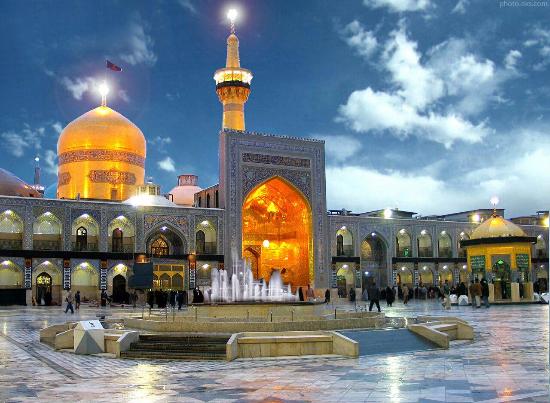Ali ibn Moosa (Ali the son of Moosa) known as Reza is of descendants of Muhammad, the holy prophet of Islam, cherished by the Muslims of the whole world for his high spiritual levels and importance whom born in Medina and moved to Thus in Iran after the order of Ma’mūn, the seventh Abbasid caliph, when the most significance part of Imam Reza’s life regarding his political and religious role initiates and conclude by his martyrization.
The role of Imam Reza in the guidance of the public in his lifetime and his prominent status as a religious figure lead to the transformation of his holy shrine as one of the religious hubs for Muslims and especially Shias which has had large architectural developments during the history. The complex was so respected by the Shia believers and various governments, whether Shia or Sunni, that has benefited from constant restoration, maintenance and new extensions during different eras. Plenty of tourists visit the Holy shrine each year and know it as the largest and most significant religious places for Iranians and other Muslims all around the world. Kumpfer, a German tourism who visited Iran during (1096-1105 AH/ 1685-1694 AD) has some words on the holy shrine complex. “The most outstanding, extensive and engaging holy shrine in Iran, undoubtedly, are as follows: first, Imam Reza’s Holy Shrine in Mashhad.
Second, his sister’s Holy shrine in Qom and, third, Sheikh Safi al-din Khānegāh and Shrine Ensemble in Ardabil”, Kumpfer stated.
This historic architectural complex accompanies unique and distinctive ethics and rituals to be known as an inseparable heritage of the complex and the complicated culture of its wider setting. In fact, the genuine values of the heritage associates not only with its magnificent architecture and structural system but also with all the rituals, all together implicating the unique spiritual spirit of Imam Reza.
Dusting is one of the oldest rituals of Astane-e Qods with 500 years of constant continuation which on the event of specific occasions performs with particular formalities. As well as playing Naqareh (a specific wind instrument) in various events and times. Of other rituals, the sweeping, Waqf, granting free food and services to assist others and the mankind, various types of citing, etc. can be mentioned.
In a general perspective, the function, structure, decorative elements, facades and surfaces of the buildings all in all symbolize the ideology, the through religious unification and the evolution of the complex. This holy shrine is not just a shrine but, in a larger scale, is an institution and an identity formed and developed based on the religious ideology and believes. The holy complex comprises of tens of valuable architectural heritages around the central holy shrine which are all with political and social importance.
Formation of Mashahd, as a city and its development is indebted to creation of the holy shrine. Thus the complex becomes the religious, political, social and also artistic center for Mashhad. It also, immensely, influence the economic status of the city. The first built structure in the complex, is the holy shrine under which the tomb of Imam Reza is located. This architectural heritage, due to its long lifespan, glorious decorative elements such as tiles, mirror decorations, gilded dome, stone-works, plaster-works, etc. incorporate sublime tangible and intangible values.
The gilded dome, known as Qubba, regarding its height and structure is of exceptional qualities. A double-shelled dome with Muqarnas underneath. The space between the two shells of the dome is almost 13.60 m high, while the height of the walls is 18.80 m. In total, the height of the structure from the ground level to the top of the dome is 31.20 m. on the plinths, exquisite octagonal tiles known as “Sanjari tiles”, from seljuq era (557 AH) are used.
Gowharshad mosque, of other significant historic architectures within the complex, due to its fine decorative arts and tiles is considered as masterpieces of Iranian Architectures from Teimurid era. The structure is built by the distinguished architect of Teimurid time, Qavam al- din ibn Zein al- din Shirazi by use of brick and gypsum in Islamic architectural style. Allah verdikhan dome, Hatam khani dome, Do Dar School, Parizad School and various monumental buildings such as minarets, Saqqa khanehs (water houses), Neqareh Khanehs, etc., as well as the museum objects and manuscripts in the Astane-e Qods collections are of other valuable elements of the complex.
Imam Reza Holy Complex
December 20, 2021
0 comment

Comment (0)